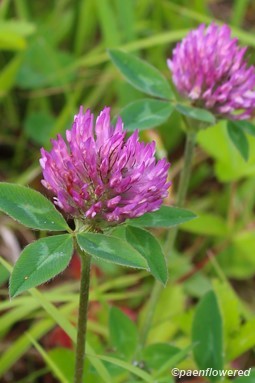Trifolium pratense
Trifolium pratense red clover
This familiar legume plant is native to Europe, Western Asia and northwest Africa, but has been introduced to temperate areas around the world. It is used as a livestock forage crop in the United States and has escaped cultivation to grow extensively in old fields, meadows, gardens, forest edges and lawns. It does not survive as well as the related white clover in frequently mowed lawns because its larger size makes it more vulnerable to damage. It does add fertility to the soil by "fixing" nitrogen gas to form nitrate fertilizer.
This species is a biennial or short-lived perennial herb that can grow 20-80 cm tall. The flowers are dark pink or magenta with paler bases. Individual flowers are pea-like in form. The flowers form in dense rounded clusters at the ends of the stalks. The flowers turn brown and papery with age.
The flowers attract bees, butterflies and other insects for pollination. The blooming period is May to September. The fruit is a one-seeded pod. The plant is rich in proteins, vitamins and minerals and is consumed by many wild animals. The leaflets are dark green except for a V-shaped lighter area. The red clover is known to contain isoflavins that mimic the effects of estrogen. Traditional herbalists have used it to treat a wide variety of ailments, including the effects of menopause. There are possible side effects and drug interactions and so it should be used with caution.
The plant is also known as bee bread, cow clover, cow grass, meadow clover and purple clover.
Habitat & Range
Naturalized in fileds, pastures and roadsides.
Present throughout the state.
| EMP: | FACU |
|---|---|
| NCNE: | FACU |
Phenology
Flowers May through October.











Comments
Have you spotted this plant in your area? We'd love to hear about your experience! Share your comments or questions about the plant below. Comments are moderated before posting.